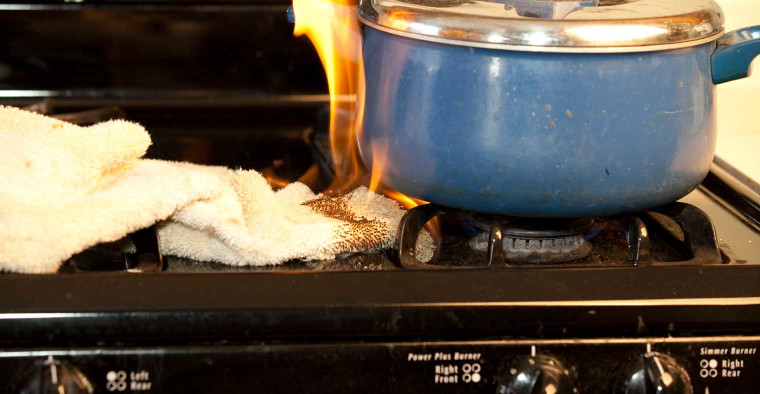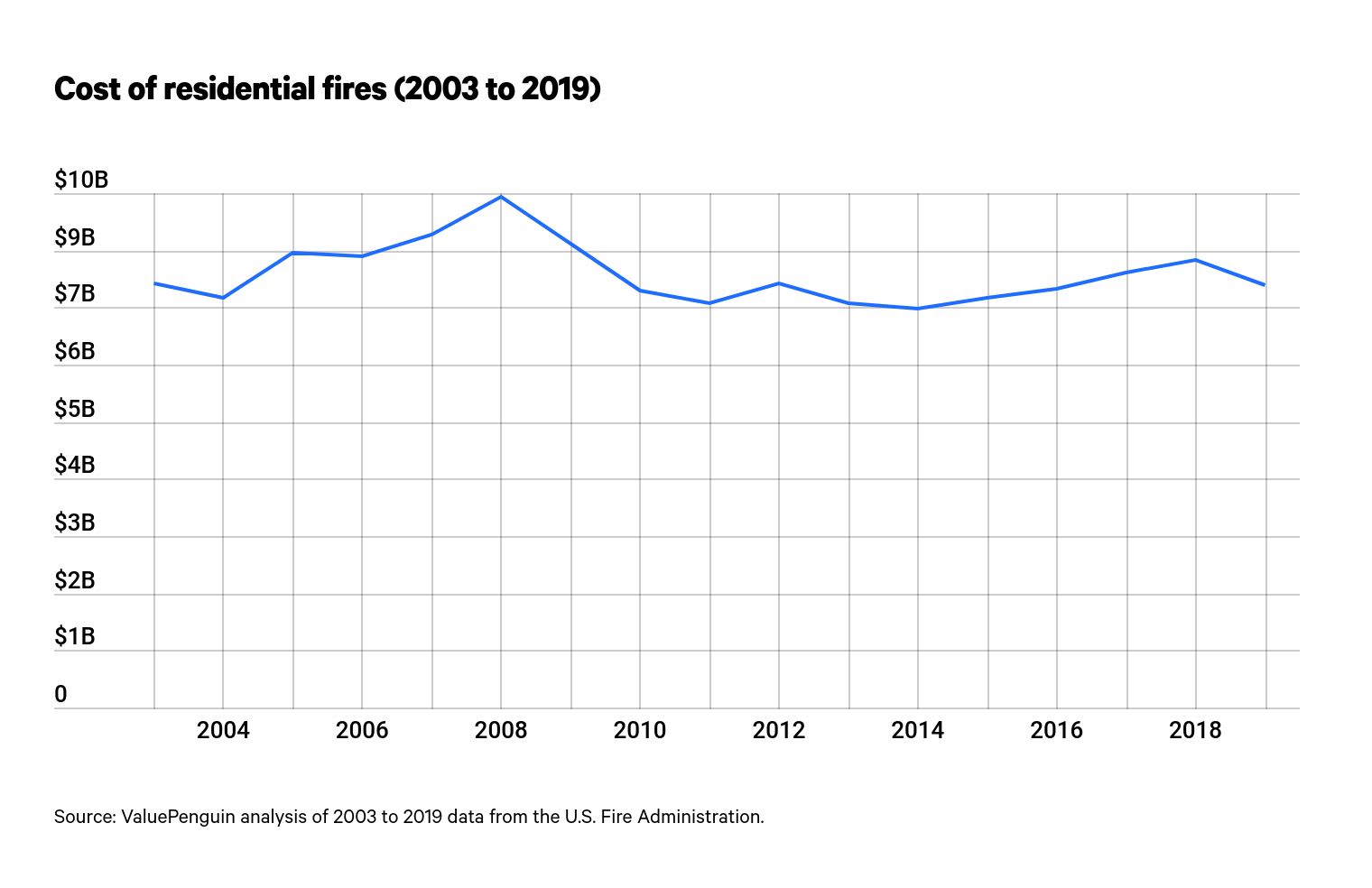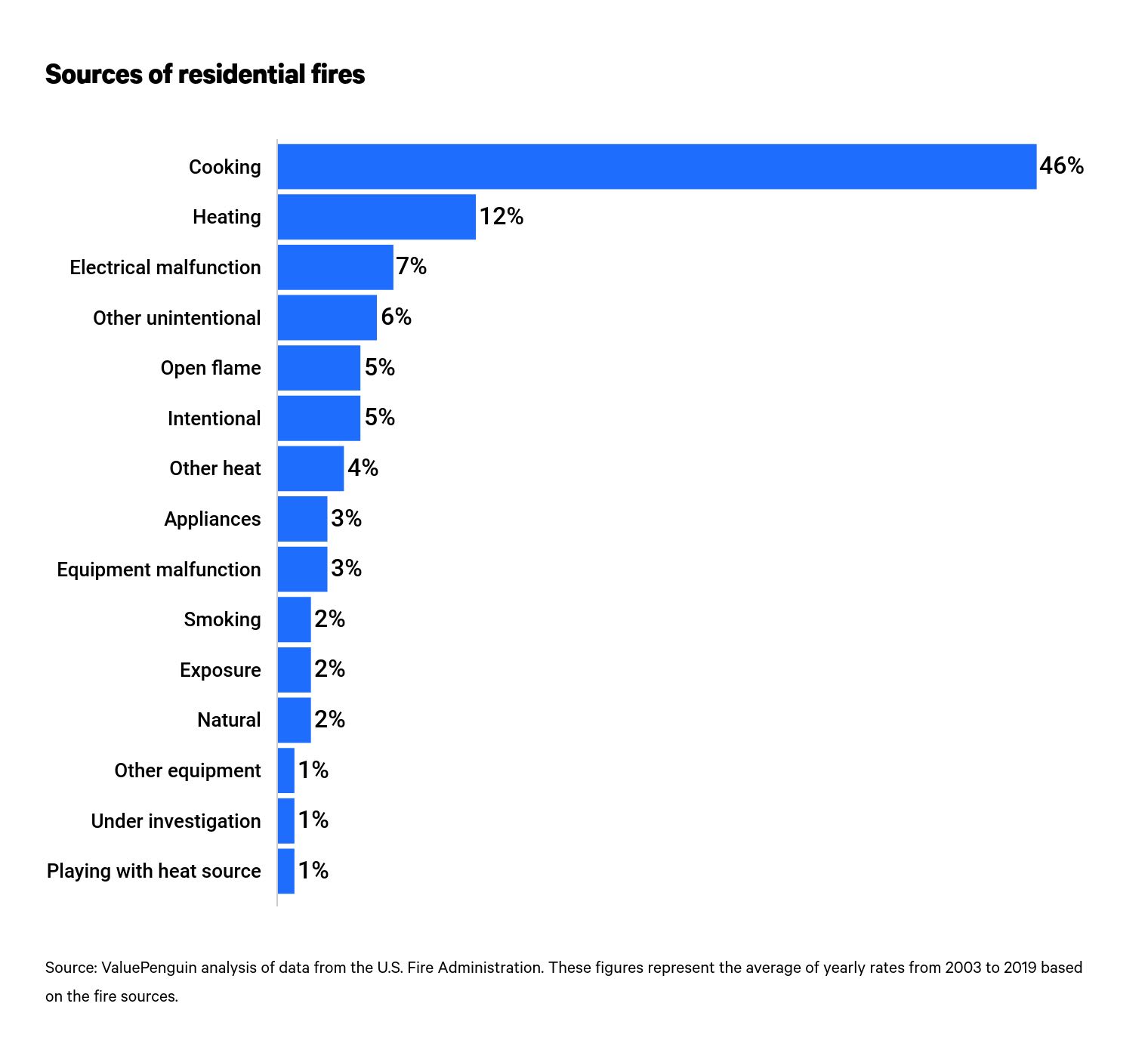Homeowners Insurance
Average Cost of Home Insurance Rises 27% After a Fire

Residential fires can lead to financially and emotionally difficult recoveries. ValuePenguin compiled homeowners insurance rates from homes before and after a blaze that resulted in a total property loss, finding that fire damage led to higher insurance rates nationally — and in every state.
Nearly two decades' worth of U.S. Fire Administration data shows that residential fires have caused billions of dollars in damage to homes across the country. From 2003 to 2019 — the latest available data from the agency — residential fires have caused an average of $8.1 billion in damage annually, or $138 billion total.
Insurance providers cover part of the fire damage costs on behalf of their policyholders, but these expenses result in higher prices. ValuePenguin calculated that the average cost of home insurance increases 27% after a residential fire. Depending on the state, average rates could rise by as much as 42% or as little as 6%.
Key findings
- Home insurance becomes more expensive in every state after a fire. The cost of homeowners insurance increases by an average of 27% across every state and the District of Columbia after a blaze.
- Fires have the largest impact on home insurance premiums in Mississippi and West Virginia. In the two Southern states, the average cost of insurance increases by 42% after a blaze. The cost of coverage increases the least — 6% on average — in Florida.
- With it being National Chimney Safety Week, it's important to know that 12% of residential fires are attributable to chimneys and other heating sources, according to the U.S. Fire Administration. From 2003 to 2019 — the latest available data — these fires were responsible for a yearly average of 5% of the damage costs from all residential fires and 6% of deaths.
- 67,770 people were injured in chimney or fireplace fires from 2011 to 2020, according to the U.S. Consumer Product Safety Commission's National Electronic Injury Surveillance System (NEISS). The annual number of people treated in hospitals for related injuries fell by 44% during this period — from 7,874 in 2011 to 4,405 in 2020.
Fire damage causes home insurance costs to rise in every state, with average increases of 40% or higher in 4 states
After a fire destroys an entire dwelling, the annual cost of that home's insurance policy rises by an average of 27% across all states and the District of Columbia. However, losing a home to a fire leads to different insurance premium changes depending on the state in which it occurred.
In Florida, home insurance costs rise by an average of 6% after a fire — the lowest of any state and the only one below 10%. Conversely, home insurance rates in Mississippi and West Virginia increase by an average of 42% after a fire, making them the most expensive states in which to experience fire damage.
Rank | State | Average annual cost after fire | Difference |
|---|---|---|---|
| 1 | Mississippi | $2,236 | 42% |
| 2 | West Virginia | $1,673 | 42% |
| 3 | Idaho | $1,486 | 41% |
| 4 | Oregon | $1,674 | 40% |
| 5 | Pennsylvania | $1,251 | 39% |
| 6 | Michigan | $2,156 | 39% |
| 7 | Maine | $1,359 | 38% |
| 8 | Wisconsin | $1,539 | 37% |
| 9 | Missouri | $2,769 | 36% |
| 10 | Illinois | $1,836 | 35% |
| 11 | North Carolina | $1,897 | 35% |
| 12 | Nevada | $1,469 | 34% |
States are arranged by the percentage difference between the cost of home insurance before and after a fire. The percentages are rounded.
Aside from Mississippi and West Virginia, two other states experience rate increases averaging more than 40%. Home insurance premiums in Idaho go up by 41% on average after a fire, while blazes cause rates in Oregon — which experiences a high number of wildfires — to increase by 40% on average.
The most expensive state for home insurance after a fire is Colorado, but fire damage results in a lower-than-average markup there than in the rest of the country. After a fire destroys a home in Colorado, the cost of homeowners insurance increases by an average of 21% — six percentage points below the average.
Do you need special fire insurance?
Home insurance policies typically cover damage caused by fires — wildfires or residential fires. Fire damage is even covered if a blaze is caused by an event not typically covered by a home insurance policy, like an earthquake.
Some homeowners or tenants may want to — or even have to — purchase a separate fire insurance policy in addition to their regular home or renters insurance coverage. Owners of homes with a history of claims or ones that aren't a primary residence may purchase a stand-alone fire policy to protect against damage. Additionally, owners of homes built in high-risk areas with frequent wildfires may be refused coverage by traditional insurance companies. These homeowners will instead have to purchase Fair Access to Insurance Requirements (FAIR) plans to receive insurance coverage.
Residential fires have caused an average of $8.1 billion in yearly damage since 2003
At the national level, residential fires caused an average of $8.1 billion in annual damage between 2003 and 2019, according to the latest data from the U.S. Fire Administration. In total during this period, residential fires caused $138 billion in damage to homes.
During this period, the damage from residential fires didn’t fade. Rather, the cost of fire damage increased slightly from $7.9 billion in 2003 to $8.5 billion in 2005 to a high of $9.5 billion in 2008 before receding to $7.9 billion in 2019. In 2019, the amount of damage caused by residential fires was less than a single percentage point different from 2003.
From 2003 to 2019, there was never a year with fewer than 350,000 residential fires. On average, there were 375,059 house fires yearly, totaling 6.4 million. In 2019, the year with the fewest fires, there were still 354,400 blazes — though this represents a decrease of 7% compared to the total (381,200) in 2003.


Changes to the cost and number of residential fires from 2003 to 2019 were largely insignificant.
Residential fires resulted in the deaths of tens of thousands of people during this period. Statistics show 45,895 were killed from 2003 to 2019 in residential fires, an average of 2,700 yearly.
Cooking sources have been responsible for an average of 46% of yearly residential fires since 2003, followed — though not closely — by heating equipment
Most residential fires are caused by heating sources used for cooking. Data shows that cooking fires, stoves, ovens and other fixed sources of heat were to blame for an average of 46% of the yearly fires between 2003 and 2019. Further, between 2014 and 2019, cooking sources were the cause of at least half of residential fires, with a high point of 52% in 2017.
Behind cooking were heat sources, such as chimneys and fireplaces. These sources were responsible for fires 12% of the time on average — ranging from a high point of 16% in 2003 to a low point of 9% in 2019. Heating sources were responsible for a yearly average of 5% of all damage related to residential fires in this period. These fires led to 2,970 deaths, or an average of 6% yearly of all residential fire-related deaths.
Sept. 26 to Oct. 2, 2021, is National Chimney Safety Week, and data reveals that many people are injured each year from fires related to chimneys and fireplaces.

Injury figures from the NEISS revealed that 67,770 people received hospital care for injuries sustained from chimneys and fireplaces between 2011 and 2020. On average, that’s 6,777 people injured yearly. However, fewer required (or sought) hospital attention in 2020 than in 2011. In fact, the number of injuries caused by chimneys and fireplaces fell by 44% during this period, according to NEISS figures.
Methodology
ValuePenguin analyzed U.S. Fire Administration data on residential fires from 2003 to 2019 — the latest available. Researchers compared the number of heating fires to the total number of fires during this time. The U.S. Fire Administration classifies heating fires as those that start in:
- Flues
- Fireplaces
- Chimneys
- Fuel burners or broilers
- Central heating units
- Fixed and portable heating units
- Furnaces
- Boilers
- Water heaters
This study also utilizes injury data from the NEISS. The data, covering 2011 to 2020, denotes injuries from sources that caused at least 1,200 yearly injuries that required hospital care. Those sources include:
- Wood- and gas-burning fireplaces
- Built-in fireplaces
- Electric fireplaces
- Brick, stone or masonry chimneys
- Metal chimneys, stovepipes or flues
- Unspecified fireplaces
- Unspecified chimneys
Finally, ValuePenguin calculated the impact of fires on the cost of homeowners insurance using Quadrant Information Services. Researchers gathered rates for homes insured to the median value of a home in each state.
ValuePenguin's analysis used insurance rate data from Quadrant Information Services. These rates were publicly sourced from insurer filings and should be used for comparative purposes only. Your own quotes may be different.
